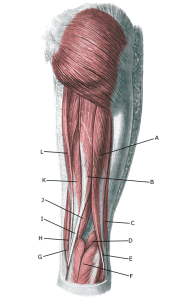Anatomy
In principle, any muscle on the back of the thigh can rupture, but most commonly it is one of the 3 large thigh muscles (hamstrings), whose function is to bend the knee and extend the hip. The hamstring muscles include the semitendinosus and biceps femoris (which attach together in the conjoin tendon at the gluteus) and semimembranosus. The muscles attach just below the knee joint on the fibula and tibia.
Injuries in muscles can be localised in the muscle tissue itself, in the fascia around/between the muscles or in the tendon part of the muscles, which has a major impact on prognosis (muscles heal much faster than tendons).
A. M. biceps femoris (caput longum)
B. M. semitendinosus
C. Caput breve m. biciptitis femoris
D. M. planataris
E. Tendo m. bicipiti femoris
F. M. gastrocnemius
G. M Sartorius
H. M gracilis
I. M. semimembranosus
Cause
When one of the thigh muscles is subjected to a load that exceeds the muscle strength, a rupture occurs. The vast majority of rear thigh injuries occur when the rear thigh is stretched while the muscle is contracted (eccentric contraction), for example in a sprint or push-off.
Most ruptures are partial muscle tears. The rupture is often accompanied by painful bleeding, which can increase after a few days due to the formation of a hygroma.
Symptoms
In mild cases, a localised soreness is felt after the strain (‘muscle strain’, ‘threatening fibre’). In more severe cases, a sudden shooting pain is felt in the thigh muscle (‘partial muscle rupture’, ‘fibre rupture’). In the worst case scenario, you feel a violent slap and then it is impossible to use the muscle (‘total muscle rupture’).
The following three symptoms are characteristic of muscle injuries: Pain when pressing, stretching and activating against resistance (bending at the knee and stretching at the hip); in the worst case, a violent snap is felt, after which it is impossible to use the muscle (‘total muscle rupture’). With total tears, a defect in the muscle can often be seen and felt, and a swelling (the contracted muscle bulge and bleeding) is felt above or below the tear.
Most commonly, tears occur in one of the 3 large thigh muscles in the centre of the thigh, whose function is to bend the knee and extend the hip. The bleeding can become so severe that it causes increasing pain and risks triggering acute musculoskeletal syndrome.
Examination
In mild cases with only minimal soreness and no discomfort during normal walking, a medical examination may not be required. However, the severity of soreness is not always a measure of the extent of the injury. For more pronounced soreness, pain and loss of strength in the back of the thigh, a medical examination is advised to ensure diagnosis and treatment. Diagnosis is usually made by general clinical examination. If there is any doubt about the diagnosis, an ultrasound or MRI scan can be performed).
See ultrasound scan of muscle rupture
The larger the haemorrhage assessed by ultrasound scan, the longer the healing time. In case of heavy bleeding, these can be drained ultrasound-guided, which is believed to shorten the course.
Treatment
Treatment usually includes relief and rehabilitation. Only in very rare cases is surgery indicated. Even large tears in the thigh muscle can usually be rehabilitated without functional damage (but often cosmetic with an irregular thigh muscle). Large muscle haemorrhages can benefit from ultrasound-guided drainage, which promotes healing.
Localising whether a tear is in the muscle, in the fascia or in the muscle tendon is of great importance for the speed of rehabilitation. This can often be determined during the clinical examination. If in doubt, ultrasound or MRI scans can reveal the location of the injury.
The Nordic hamstring (van Dyk N, Behan FP, Whiteley R. 2019) and (Street SB, Kaminski T. 2020) exercise programmes have been shown in several studies to prevent a significant proportion of hamstring injuries.
Complications
If it doesn’t progress smoothly, you should be re-examined (again) and consider whether the diagnosis is correct or if complications have arisen:

